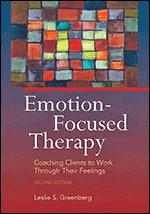Therapy
Emotion-Focused Therapy: Background, Types and Effectiveness
THC Editorial Team June 7, 2021

Contents
- Overview
- How Does Emotion-Focused Therapy Work?
- Types of Emotion-Focused Therapy
- The Effectiveness of Emotion-Focused Therapy
What Is Emotion-Focused Therapy?
Emotion-focused therapy (EFT) is a neo-humanistic and experiential approach to psychotherapy premised on the idea that emotions underpin enduring change in an individual’s well-being. Within this framework, emotional expression is considered crucial for mental well-being and healing because emotions inform people’s needs, values, and goals.1 Emotions also affect how people feel about situations, what importance they assign to them, and how they act in response.
A core belief within EFT is that human emotions are “foundational in the construction of the self and a key determinant of self-organization.”2 In other words, emotions serve to help individuals process information, gain insights into themselves and the world around them, and guide their actions. In doing so, emotions help promote healing, personal growth, and well-being. As social beings, human emotional awareness is as important as paying attention to thoughts or actions.
Emotion-focused therapy draws from gestalt, client-centered, experiential, and existential therapies, as well as emotion theory and task analysis.1 EFT was first presented in 1984 by Laura Rice and Leslie Greenberg in their book, Patterns of Change, and again in 1987 by Greenberg and Jeremy Safran in their book, Emotion in Psychotherapy. 1 Emotion-focused therapy has since received support from well-established empirical research showing its effectiveness for individuals, couples, and families.1,3
How Does Emotion-Focused Therapy Work?
Emotion-focused therapy is most often practiced as a short-term therapy for individuals, couples, or families that requires eight to 20 structured sessions to yield benefits.4 This type of therapy provides clients with tools to recognize and productively use certain emotions. According to EFT theory, the actual change process comes from accepting and experiencing underlying emotions, transforming them, and devising an alternate narrative.4
During an EFT session, therapists act as emotion coaches. In particular, they work to facilitate emotion-focused coping skills, aiding clients in gaining awareness of, accepting, and making sense of emotional experiences. Therapists and clients engage in two major phases in EFT: arriving and leaving.2 Arriving occurs when a therapist and a client work together to identify—or arrive at—a core emotion. If that emotion is adaptive, meaning it positively aids the client and is elicited in the way it is intended to, the EFT therapist uses it to help guide the client toward an action that will allow that emotion to leave.5 When an emotion leaves, and the client has relinquished it, they can develop healthier emotions, thoughts, and coping strategies in its place.
The relationship between the client and the therapist is as meaningful as the emotional processing accomplished in the sessions.4 In EFT, both the therapeutic relationship and the actual emotional processing are mechanisms of change. The relationship provides the client with the safety to thoroughly explore painful emotions and engage in the therapeutic process. Emotional processing allows clients to access maladaptive emotions, such as fear or anger, and modify them. To modify maladaptive emotions, the therapist helps clients pay attention to and explore their feelings and associated meanings.
Four essential processes are followed in EFT sessions:6
- The client and therapist work together to establish what the focus of their session will be. This collaboration facilitates a trustworthy alliance, as they are aligned in their goals and objectives. In the beginning, the sessions are very structured. Over time, as the therapist and the client work on the set goals, each session may begin in a much more open-ended manner.
- The therapist ensures they are empathetically responding to their clients’ struggles. Often, clients come to therapy to reduce negative emotions. Therefore, therapists focus on helping their clients comfortably approach and work through emotional pain with empathy and validation. The therapist facilitates a dialogue to review the emotions, validate the client’s experience, find ways to reduce the intensity of the feelings, and help the client find healthier ways to process their emotions.
- The therapist encourages the client to access and respond to any emotional experiences that emerge. They also guide the client to develop ways to respond with healthy resources, such as the client’s wants, needs, strengths, ability to have insight, assertiveness, and self-compassion. Being able to acknowledge and validate the healthy ways an individual behaves promotes growth.
- As the client becomes more comfortable sharing their experiences, the therapist promotes reflection and exploration into the client’s emotional experience. Through discussion, they work together to identify the source of emotions, understand why the client responds in particular ways, and elaborate on what the experience means in the broader context of the individual’s life. The aim is for the client to enter a space of deep reflection where they can pose and answer questions about themself.
Types of Emotion-Focused Therapy
The overall goals of Emotion-focused therapy differ subtly according to the type of session: individual, couple, or family. The objectives of all three types generally focus on generating secure relationships and building better communication patterns.
Emotionally-Focused Individual Therapy
Emotionally-focused individual therapy (EFIT)4 is EFT for individual clients; it provides information about ways to more adaptively manage emotions in order to modify how clients perceive and conduct themselves. The therapist encounters the client’s vulnerability with empathy, patience, and balance. The therapist also tries to foster secure attachment styles (i.e., how an individual can relate to others) and enhance their clients’ interpersonal relationships.
Emotionally-Focused Couples Therapy
Emotionally-focused couples therapy (EFCT)4 is EFT within a partner system and works to help intimate partners elaborate and rephrase or rethink their emotional responses toward one another. The therapist facilitates more positive interactions and patterns of behavior between partners. The main objective is to develop, maintain, and solidify a secure bond between them.
Emotionally-Focused Family Therapy
Emotionally-focused family therapy (EFFT)4 is EFT within the family system and works to reestablish secure familial patterns. The therapist seeks to foster effective attachment and caregiving responses to repair emotional bonds. If there are adverse interactions, the therapist restructures those interactions and guides the entire family toward new, healthier, more communicative relationships. The therapist works to establish space within the family to understand any unacknowledged feelings associated with negative interaction patterns. By reframing, for example, familial emotional distress and problematic behaviors in children, families can meet unmet needs and learn how to be more responsive and accessible.
The Effectiveness of Emotion-Focused Therapy
Research has demonstrated that emotion-focused therapy effectively treats various mental health issues among different demographic groups across North America, Australia, New Zealand, Europe, and Asia. Specifically, studies have demonstrated the following:
- EFT showed more significant symptom reduction than pharmacotherapy did for female romantic partners struggling with major depressive disorder in couples therapy.7
- Survivors of child abuse who received EFT demonstrated significantly improved symptoms in multiple domains of disturbance, including current problems related to abuse, interpersonal problems, and self-affiliation (i.e., relationship with the self); emotional improvement was maintained even after nine months.8
- Couples who received EFT reported significantly higher levels of marital satisfaction9 and improvement in trust and forgiveness.10
- After EFT, women with diagnoses of binge-eating disorder and bulimia nervosa exhibited a significant decrease in the frequency of binges and improvements in mood and emotion regulation.11
Studies have also shown that emotion-focused therapy may help individuals with the following mental health conditions:
- depression12,13
- eating disorders14
- trauma15
- borderline personality disorder16
- social anxiety disorder17













